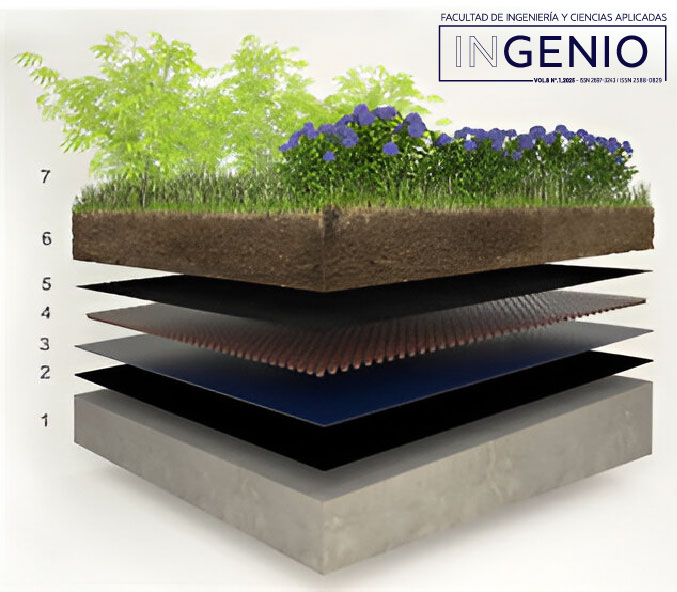Evaluación del Impacto de la Implementación de Techos Verdes en el Dimensionamiento de Sistemas de Alcantarillado Urbano
Contenido principal del artículo
Resumen
Este artículo analiza el impacto de implementar techos verdes en cubiertas inaccesibles en la urbanización Ecovilla Challuabamba, Cuenca, Ecuador. Mediante el uso del programa SWMM, se comparó el sistema de alcantarillado convencional con uno que incorpora techos verdes, evaluando tormentas de diseño con periodos de retorno de 2 a 50 años. Para estimar la escorrentía, se utilizaron modelos como el Número de Curva, Horton y Green AMPT, considerando variables como clima, sustrato y pendiente. Los resultados muestran que los techos verdes reducen el caudal pico en un 44.5%, el calado en un 6.9% y la velocidad en un 38.1%, según el modelo de Número de Curva. Estos hallazgos sugieren que los techos verdes pueden mitigar inundaciones al disminuir la escorrentía superficial y permitir reducir el tamaño de las tuberías, destacando su potencial para aumentar la resiliencia urbana y promover la sostenibilidad en el desarrollo urbano.
Descargas
Métricas
Detalles del artículo

Esta obra está bajo una licencia internacional Creative Commons Atribución-NoComercial-SinDerivadas 4.0.
Citas
A. y. T. E. Ministerio del Ambiente, «Dirección de Comunicación Ministerio del Ambiente,» 21 marzo 2018. [En línea]. Available: https://www.ambiente.gob.ec/ecuador-fomenta-la-construccion-ciudades-verdes-saludables/#.
Rodríguez Emmanuel, Villagra Karolina, «Evaluación de un techo verde bajo eventos de precipitación sintéticos para caracterizar el comportamiento del flujo por escorrentía,» 2019. [En línea].
Lanarc Consultants Ltd, Kerr Wood Leidal Associates Ltd., and Ngan, G., «Stormwater Source Control Design Guidelines 2005,» 2005. [En línea]. Available: http://www.metrovancouver.org/about/publications/Publications/Storm_Source_Control_P.
B. Woods-Ballard, R. Kellagher, P. Martin, C. Jefferies, R. Bray y P. Shaffer, Site handbook for the construction of SUDS, Londres: Ciria, 2007.
Groundwork Sheffield and Environment Agency, «The GRO green roof code,» 2011. [En línea]. Available: http://www.thegreenroofcentre.co.uk/Library/Default/Documents/GRO%20ONLINE.pdf.
J. Aguillón y G. Arista, «ResearchGate-Monitoreo y Simulaciones del Hábitat,» 2016. [En línea]. Available: https://www.researchgate.net/publication/337620911_Monitoreo_y_Simulaciones_del_Habitat.
Galarza et al., «PROPUESTA DE MEJORAMIENTO TECNOLÓGICO DE TECHOS VERDES PARA EL CLIMA TROPICAL ANDINO,» Ciencia e Ingeniería Neogranadina, p. 99, 2017.
K. Luckett, Green Roof Construction and Maintenance, Estados Unidos: McGraw-Hill, 2009.
Camacho et al., «Techos verdes: una estrategia sustentable Green,» Tecnología en Marcha, p. 79, 2020.
INAMHI, DETERMINACIÓN DE ECUACIONES PARA ELCÁLCULO DE INTENSIDADES MÁXIMAS DE PRECIPITACIÓN, Quito, 2015.
Alcaldía de Cuenca, Dirección de Planificación, «PLAN DE DESARROLLO Y ORDENAMIENTO TERRITORIAL DEL CANTÓN CUENCA,» 2022. [En línea]. Available: https://www.cuenca.gob.ec/sites/default/files/planificacion/1_4_Documentos%20complementarios%20del%20PDOT_07_01_2022.pdf.
Secretaria del Agua, Normas de Diseño para Sistemas de Abastecimiento de Agua Potable, Disposición de Excretas y Residuos Líquidos en el Área Rural, Quito, 1992.
Servicio de Investigación Agrícola USDA, «Laboratorio de hidrología y teledetección: Beltsville, MD,» 2016. [En línea]. Available: https://www.ars.usda.gov/research/software/download/?softwareid=492&modecode=80-42-05-10.
U.S. Environmental Protection Agency (EPA), Manual del Usuario, SWMM Modelo de Gestión de Aguas Pluviales 5.0 vE, National Risk Mangement Research Laboratory, 2005.





